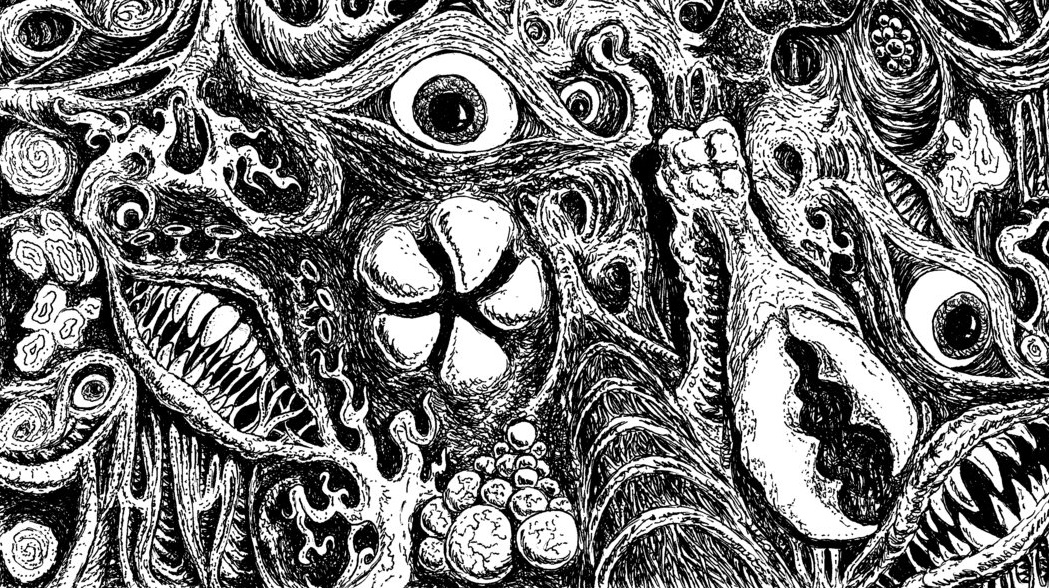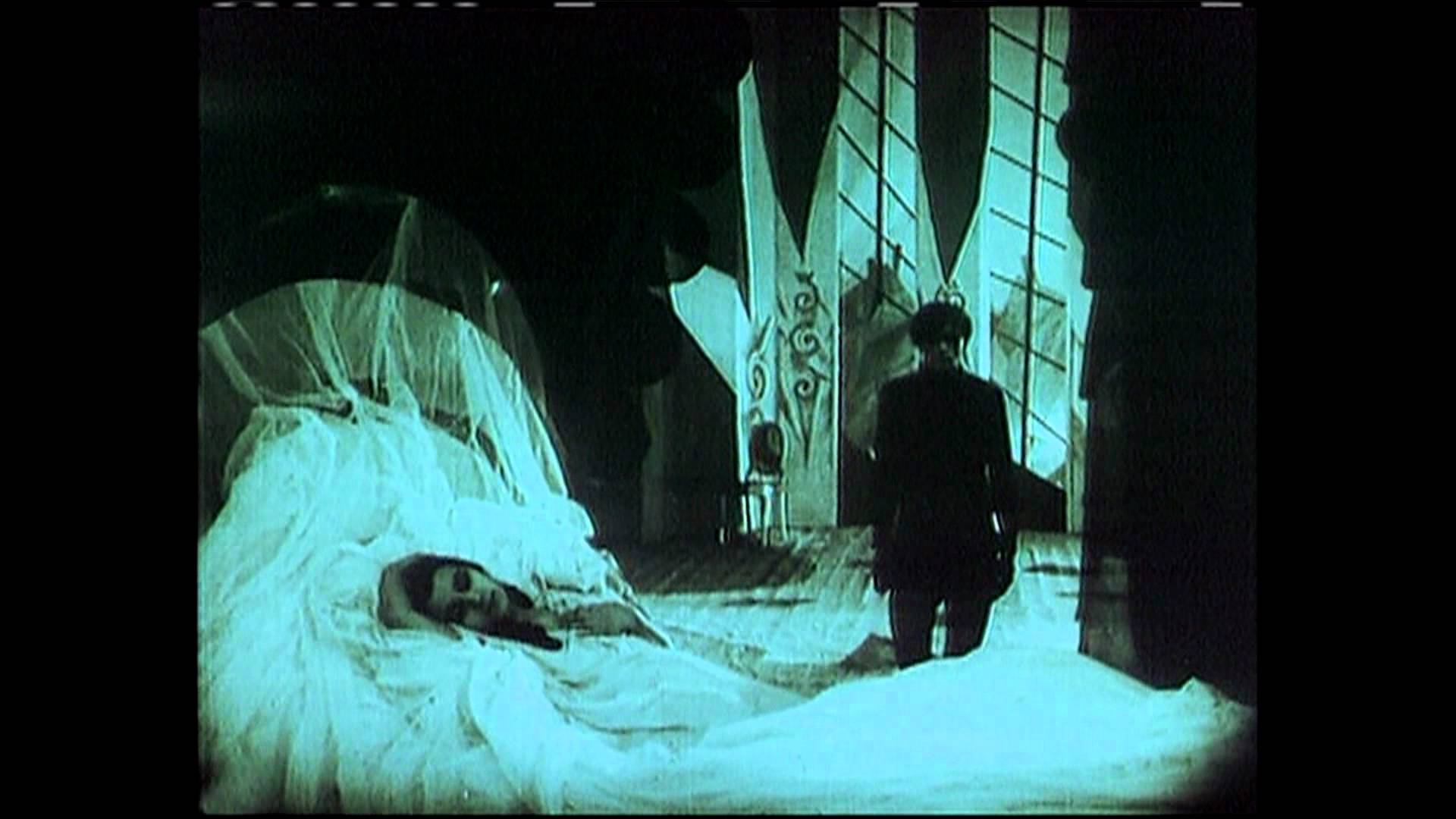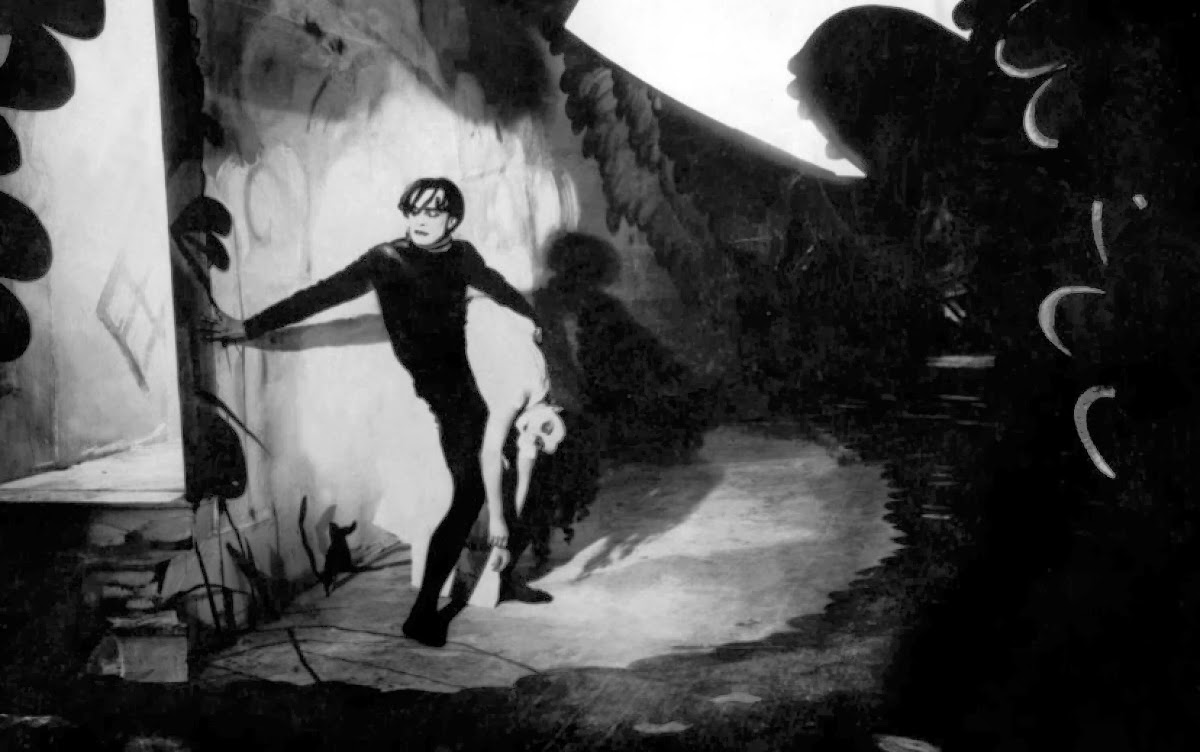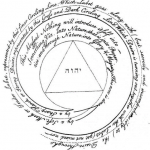by Amy Ireland
And now, in that rise of masonry to which his eyes had been so irresistibly drawn, there appeared the outline of a titanic arch not unlike that which he thought he had glimpsed so long ago in that cave within a cave, on the far, unreal surface of the three-dimensioned earth.[note]H.P. Lovecraft, “Through the Gates of the Silver Key“, The Dreams in the Witch House and Other Weird Stories (London: Penguin, 2004), 278.[/note]
Lönnrot
There is a short story by Jorge Luis Borges which details an elaborate game of geometrical entrapment.[note]Jorge Luis Borges, ‘Death and the Compass’, Fictions, trans. Andrew Hurley (London: Penguin, 1998) 111-23.[/note] The game is at once a temporal and spatio-cartographic one. It is played over a period of four months, on the fourth of each month, across a series of cardinal coordinates: a hotel in the North, a paint factory in the West, a tavern in the East, and an abandoned villa in the water-logged southern outskirts of the story’s unidentified city. The players are the police detective Erik Lönnrot, and his nemesis, a Barcelona gangster known as ‘Red’ Scharlach.
Knowing Lönnrot to be one of those peculiar creatures that prefers a well-wrought puzzle to the legislative drudgery of trying and condemning a criminal, Scharlach exploits the accidental murder of a Jewish mystic to compose a false, rhomboidal “labyrinth” (as he refers to it), whose contours prove irresistible to the “recklessly perspicacious” mind of the detective.[note]Ibid., 111. Sharlach describes the vision that preceded his construction of the puzzle, haunted by the double-faced statue of Hermes that stands in the garden of the Villa Triste-le-Roi: “Nine days and nine nights I lay between life and death in the desolate symmetrical villa, consumed by fever, and that hateful two-faced Janus that looks toward the sunset and the dawn lent horror to my deliriums and my sleeplessness. I came to abominate my own body, I came to feel that two eyes, two hands, two lungs are as monstrous as two faces. […] I sensed that the world was a labyrinth, impossible to escape — for all roads, even if they pretended to lead north or south, returned finally to Rome, which was also the rectangular prison where my brother lay dying, which was also the Villa Triste-le-Roi. During those nights, I swore by the god that sees with two faces, and by all the gods of fever and mirrors, to weave a labyrinth around the man who had imprisoned my brother.” 121.[/note] There are just enough false clues hidden in the puzzle to seduce Lönnrot into believing his solution, which he arrives at by following an incomplete pattern of fours — from the enigmatic declaration that ‘the [nth] letter of the Name has been written’ left at the scene of each crime, invoking the four letters of Tetragrammaton with the third as yet unwritten; to the fact that the three murders thus far composing the puzzle, although exoterically committed on the third of each month, can be esoterically understood as having been committed on the fourth; the adjacency to each of the three victims of a quadrilateral figure of some kind, and the situation of the three crimes at cardinal points on the city’s map: North, West, and East. Drawing a rhombus to connect the points, and with that revealing the location where the fourth murder will take place, Lönnrot delivers himself directly — although a day too early — into the hands of Scharlach and his goons, who are waiting for him in at the fourth cardinal point, the Villa Triste-le-Roy.
An intriguing passage follows:
For the last time, Lönnrot considered the problem of the symmetrical, periodic murders.
“There are three lines too many in your labyrinth,” he said at last. “I know of a Greek labyrinth that is but one straight line. So many philosophers have been lost upon that line that a mere detective might be pardoned if he became lost as well. When you hunt me down in another avatar of our lives, Scharlach, I suggest that you fake (or commit) one crime at A, a second crime at B, eight kilometres from A, then a third crime at C, four kilometres from A and B and halfway between them. Then wait for me at D, two kilometres from A and C, once again, halfway between them. Kill me at D, as you are about to kill me at Triste-le-Roy.”
“The next time I kill you,” Scharlach replied, I promise you the labyrinth that consists of a single straight line that is invisible and incessant.”
He stepped back a few steps. Then, very carefully, he fired.[note]Hurley’s “invisible and endless” has been replaced with the English translation of this indirectly cited phrase (“invisible, incessant”) in Gilles Deleuze, Difference and Repetition, trans. Paul Patton (NY: Columbia University Press, 1994), 111.[/note]
The weapon is discharged. The story ends. Does the bullet collide with the living body of Lönnrot? Borges refrains from telling us.
Another two stories. A horror story and a philosophical meltdown (with one enveloped in the other).
Carter
Lovecraft’s “Through the Gates of the Silver Key”, is less a document of geometrical entrapment than one of geometrical fuite — a French word that designates both liquefaction and escape. Its protagonist, Randolph Carter, unlike those unfortunate, ‘enlightened’ men of science, who dominate the bulk of Lovecraft’s stories, seems to know precisely what he’s getting into when he returns to a “cave within a cave” known as the “Snake Den” in the wooded countryside of his youth to perform a series of rituals by means of the mysterious titular “Silver Key”.[note]H.P. Lovecraft, “Through the Gates of the Silver Key”, 278; 266.
“A fold is always folded within a fold, like a cavern in a cavern. The unit of matter, the smallest element of the labyrinth, is the fold, not the point which is never a part, but a simple extremity of the line.” Gilles Deleuze, The Fold (New York: Continuum, 2001), 6.[/note] On the day of his expedition to the cave, the 7th of October, 1928, Carter vanishes from the world, leaving behind a parked car containing a piece of parchment scattered with bizarre characters that “no man could read” and his expansive estate, containing a significant collection of esoteric lore and occult artefacts. Four years later, a close friend of Carter’s, Etienne-Laurent de Marigny; a Providence mystic, Ward Philips, and the Chicago lawyer, Ernest B. Aspinwall, convene in de Maringny’s apartment to determine the future of the Carter estate. Phillips and de Marigny, susceptible to the irrationality of their spiritual backgrounds, aren’t convinced that Carter is dead. Aspinwall, on the other hand, is perhaps too eager to confirm Carter’s death and divide the estate (of which, as a cousin, he is owed a small part). A third figure who has promised to deliver important information concerning Carter’s disappearance is invited to the meeting, the Swami Chandraputra, an “adept from Benares” and alleged confidant of Carter’s.[note]H.P. Lovecraft, “Through the Gates of the Silver Key”, 268.[/note]
The narrative that follows centres on the Swami’s account of Carter’s journey, which he claims to have received via the medium of dreams. He tells of Carter’s performance of the rite of the Silver Key in the Snake Den, of his traversal of the “First Gate” and subsequent admittance to “the earth’s trans-dimensional extension”, where Carter is said to have been subjected to
a strange, awesome mutation… a sense of incalculable disturbance and confusion in time and space, yet one which held no hint of what we recognise as motion and duration. [Punctuated, nevertheless, by] some perceptible rhythm… a faint, cryptical pulse. […] Now, there was neither cave nor absence of cave; neither wall nor absence of wall. There was only a flux of impressions not so much visual as cerebral, amidst which the entity that was Randolph Carter experienced perceptions or registrations of all that his mind revolved on, yet without any clear consciousness of the way in which he received them.[note]Ibid., 278.[/note]
Carter is then given the choice to venture even further along the trajectory he has embarked upon, and passes first through a vast, abyssal void, before fully succumbing to a total “sense of lost orientation”, feeling himself
wafted into immeasurable depths, with waves of perfumed warmth lapping against his face. It was as if he floated in a torrid, rose-tinctured sea; a sea of drugged wine whose waves broke foaming against shores of brazen fire. [T]he surgings were speaking to him in a language that was not of physical sound or articulate words. “The man of Truth is beyond good and evil”, intoned a voice that was not a voice. […] “The man of Truth has learnt that Illusion is the only reality, and that substance is an impostor.”[note]Ibid.[/note]
The profound element of horror in “Through the Gates of the Silver Key” is affirmed — imminently — as a loss of unified identity, while the waves divide and carry what Carter took to be himself across the vertiginous and unintelligible dimensionality of distended time-space, that “final cosmic reality which belies all local perspectives and narrow partial views”.[note]Ibid, 284.[/note] As he goes on to cross the threshold of the “Ultimate Gate” he relinquishes the last tenuous grasp he had retained on selfhood and personal embodiment in a dissolution that transgresses form itself. Thus unmoored, amidst a “chaos of scenes whose infinite multiplicity and monstrous diversity brought him close to the brink of madness”, the Carter-entity apprehends the limitations of the earthly notion of a tridimensional world and “what an infinity of directions there are besides the known directions of up-down, forward-backward, right-left”.[note]Ibid., 284. This is followed by a description of the splintering of Carter’s identity, strewn across the breadth-less infinity of cosmic time: “All descended lines of beings of the finite dimensions, continued the waves, and all stages of growth in each one of these beings, are merely manifestations of one archetypal and eternal being in the space outside dimensions. Each local being — son, father, grandfather, and so on — and each stage of individual being — infant, child, boy, young man, old man — is merely one of the infinite phases of that same archetypal and eternal being, caused by a variation in the angle of the consciousness-plane which cuts it. Randolph Carter at all ages; Randolph Carter and all his ancestors both human and pre-human, terrestrial and pre-terrestrial; all these were only phases of one ultimate, eternal ‘Carter’ outside space and time — phantom projections differentiated only by the angle at which the plane of consciousness happened to cut the eternal archetype in each case. A slight change of angle could turn the student of today into the child of yesterday; could turn Randolph Carter into that wizard Edmund Carter who fled from Salem to the hills behind Arkham in 1692, or that Pickman Carter who in the year 2169 would use strange means in repelling the Mongol hordes from Australia; could turn a human Carter into one of those earlier entities which had dwelt in primal Hyperborea and worshipped black, plastic Tsathoggua after flying down from Kythanil, the double planet that once revolved around Arcturus; could turn a terrestrial Carter to a remotely ancestral and doubtfully shaped dweller on Kythanil itself, or a still remoter creature of trans-galactic Shonhi, or a four-dimensioned gaseous consciousness in an older space-time continuum, or a vegetable brain of the future on a dark radio-active comet of inconceivable orbit — and so on, in the endless cosmic circle.” Ibid., 285. Nietzsche’s mad invocation, “I am all the names in history” finds a counterpart here. Friedrich Nietzsche, “Letter to Burkhardt, 6 January, 1989”,The New Nietzsche, ed. David Allison (New York: Dell, 1977), 36.[/note]
‘Here’ the incessant pulse of the waves apprises Carter of the knowledge that, by changing the angle of transection of the intensive plane he finds himself on, he can access any of the fragments of Carter-being produced upon it, wherever they may be located in cosmic time, and at whatever point they might happen to occupy in the vast spatiality of a trans-dimensional manifold. Fulfilling a long held desire to know more of that “dim, fantastic world whose five multicoloured suns, alien constellations, dizzy black crags, clawed, tapir-snouted denizens, bizarre metal towers, unexplained tunnels, and cryptical floating cylinders” which had long haunted his dreams, he takes advantage of his openness to all possible manifestations of Carter-being to voyage to a distant cosmos, escorted by “a whirring and drumming that swell[s] to a terrific thundering” and “[b]ands and rays of colour utterly foreign to any spectrum of our universe”. When he returns to individuated form, he discovers his body reconfigured, “rugose, partly squamous, and curiously articulated in a fashion mainly insect-like yet not without a caricaturish resemblance to the human outline”. He recognises the Silver Key, “still in his grasp — though held by a noxious-looking claw”.[note]H.P. Lovecraft, “Through the Gates of the Silver Key”, 288.[/note]
In a voice that has been growing progressively hoarser and even at times taking on a “forced, hollow, metallic quality”, the Swami concludes his tale by explaining how, lost in a distant universe, Carter — now in the form of the wizard Zkauba of Yaddith — discovers he has left the parchment containing the incantation required to return to the intensive plane beyond the Ultimate Gate behind, and thus surrendered his capacity to discover further possibilities of trans-personal incarnation. For immeasurable aeons, Zkauba wages an internal war with the memories retained from his life as Randolph Carter, with the Carter-splinter eventually gaining the upper claw and engineering a way to travel back to earth by means of a metallically-fortified “light-wave envelope” to recuperate the forgotten parchment.[note]Ibid., 268; 290.[/note] Succeeding in this mission, but trapped in the crustaceous form of a creature from Yaddith, Carter wears a human disguise, masking his alien face and articulated claws, and proceeds to establish a tenuous habitation among the denizens of 1930s-Boston’s dubious West End. Reading of plans to dissolve his estate in the local newspaper, Carter sends the Swami to vouch for his continued existence and obstruct the imminent loss of his treasured library, including the original copy of the coveted parchment, before it is too late. So goes the story as it is related by the Swami.
The lawyer, Aspinwall, is unconvinced by this revelation. Sensing foul-play, he attempts to wrench what he is now confident is a mask from the face of the suspected interloper, eliciting a cry of protest from the Swami that manifests as nothing more than “a wholly inexplicable rattling and buzzing sound”.[note]Ibid., 297.[/note] The lawyer succeeds in removing the disguise, revealing an image which is only rendered negatively in the description of Aspinwall’s expression, “convuls[ing] with a wilder, deeper, and more hideous epilepsy of stark panic than ever seen on human countenance before”.[note]Ibid.[/note] As Aspinwall expires from the inundation of pure shock, the Swami — now understood to be Randolph Carter himself — overspills his human form and, more Zkauba than Carter, shuffles towards the corner of the room in which stands “a curious coffin-shaped clock”, its dial decorated in “baffling hieroglyphs, and whose four hands [do] not move in consonance with any time system known on this planet”. The “alien rhythm” of the clock’s “abnormal ticking”, complemented by “the bubbling of the courtyard fountain beyond half-curtained, fan-lighted windows”, has haunted the meeting since the beginning.[note]Ibid., 295-7.[/note] Phillips and de Marigny look on in sudden apprehension, as the inhuman figure that has replaced Swami Chandraputra approaches the coffin-shaped clock, enters it — with difficulty due to its pincer-like appendages — and vanishes once and for all.
“Through the Gates of the Silver Key” is, beyond all else, a story about rhythm, and the bulk of Lovecraft’s baroque prose is dedicated to integrally evasive descriptions of the quality of the pulsing waves of energy (often described as light on spectrums inaccessible to human vision) that assail Carter as he carries out his rites and descends ever deeper and into the sensible abyss beneath individuated being. Is it not insignificant that the last word of the tale is delivered, not by de Marigny or Phillips — the two characters still inhabiting the realm of the living, extended intelligibly in space and time — but by the ticks of the coffin-shaped clock as it tempts de Marigny, alone in his study, to follow the path of his friend’s strange flight.
Challenger
In a manner not incommensurate with Lönnrot’s prediction of his own return in an avatar of another life, Carter will resurface — reconfigured once more — in the body of Professor Challenger as he appears, abducted from the Conan Doyle stories, in “The Geology of Morals”, the third plateau of Deleuze and Guattari’s A Thousand Plateaus.[note]Gilles Deleuze and Félix Guattari, A Thousand Plateaus, trans. Brian Massumi (New York: Continuum, 2004).[/note] A magical reading of the plateau would posit the lecture delivered by Challenger as an act of misdirection at the level of geometry (an explication of the hydraulics of stratification, which enfolds the greater controversy of the plateau at least one more time in the debate between Cuvier and Geoffrey: “Cuvier reflects a Euclidean space, whereas Geoffrey thinks topologically”) — a ‘misdirection’ in the sense that explication is always secondary to demonstration.[note]Deleuze and Guattari, A Thousand Plateaus, 53. (A second fold comprises the entirety of Deleuze’s philosophy: an interior exteriority animates the form of the plateau, like that which inheres in the simultaneity of the abstract machine and the strata.) Meanwhile, Deleuze and Guattari resolve the debate in Geoffrey’s favour: “Strata are topological, and Geoffrey is the great artist of the fold, a formidable artist; as such, he already has a presentiment of a certain kind of animal rhizome with aberrant paths of communication — Monsters.” Ibid.[/note] The trick occurs elsewhere, in the background, or better — at the level of the frame itself — which details the transfiguration and eventually, the disarticulation, of Challenger as he passes between and beneath the quadripartite net of content and expression.
The relationship between “The Geology of Morals” and “Through the Gates of the Silver Key” is implicit in the use of narrative devices and the recurrence of indirectly cited passages lifted directly from Lovecraft’s story, in a dosage that accumulates apace of the successive stages of Challenger’s disarticulation. Just as Carter is forced to contend with his lawyer’s incredulity, Challenger’s audience is hostile to the professor’s claims (citing “numerous misunderstandings, misinterpretations and… misappropriations”); his student Alasca, like de Marigny and Phillips, attempts (“hypocritically” — for justification makes the mistake of pre-supposing and thereby legitimating a tribunal) to defend his teaching; he begins to lose his voice, which like Carter’s “become[s] hoarser, broken occasionally by an apish cough” as later, “[s]omething animalistic in him [begins] to speak” before, “suffocating”, he threatens to lose it altogether.[note]Ibid., 48; 68; 72; 80. “When we then learn that the concept of truth in representation is divided into two directions, one according to which the true emerges in person and in an intuition, the other according to which the true is always inferred from something else, concluded from clues as that which is not there, we have no trouble in finding beneath these traditional theories of intuition and induction the dynamisms of the inquisition or the confession, of the accusation or the enquiry, which work in silence and dramatically, such that it determines the theoretical division of the concept.” Gilles Deleuze, “The Method of Dramatisation”, Desert Islands and Other Texts, trans. Michael Taormina (Los Angeles: Semiotext(e), 2002), 99.[/note] Like Carter behind the mask of the Swami, Challenger has two faces, and losing his gloves, it is revealed that his hands have been transformed into pincers. As “he” (the masculine pronoun is questioned by Deleuze and Guattari) quite literally melts down, the liquid streaming from his tunic deforms the lecture hall itself, blurring the frame and bringing into focus another room — “hung with strangely figured arras” and suffused with the fumes of burning olibanum, as if it had been concealed behind the lecture hall all along.[note]Ibid. 48; 81; Lovecraft, “Through the Gates of the Silver Key”, 264; 299.[/note] This is the description given by Lovecraft of de Marigny’s study, with its fountain burbling in the courtyard beyond, and the coffin-shaped clock stationed “deep in a niche on one side”.[note]Lovecraft, “Through the Gates of the Silver Key”, 264.[/note] The penultimate scene of “Through the Gates of the Silver Key” continues to intrude upon the narrative. Aspinwall’s panicked expression as he is confronted by Carter’s alien form appears word-for-word on the figure of a “young woman” — and, as we are told that what-remains-of-Challenger “slowly hurrie[s] toward the plane of consistency”, slipping into “an assemblage serving as a drum-gate, the particle-Clock with its intensive ticking and conjugated rhythms hammering out the absolute”, Lovecraft’s prose overflows definitively, consuming the final paragraph of the plateau with the description of Carter’s disappearance into the coffin-shaped particle-clock.[note]Deleuze and Guattari, A Thousand Plateaus, 82. “The figure slumped oddly into a posture scarcely human, and began a curious, fascinated sort of shuffle toward the coffin-shaped clock. … The figure had now reached the abnormal clock, and the watchers saw through the dense fumes a blurred black claw fumbling with the tall, hieroglyphed door. The fumbling made a queer, clicking sound. Then the figure entered the coffin-shaped case and pulled the door shut after it. … The abnormal clicking went on, beating out the dark, cosmic rhythm which underlies all mystical gate-openings…”. Ibid.[/note]
On the level of philosophical exposition, “The Geology of Morals” introduces the notions of territorialisation, deterritorialisation and reterritorialisation in relation to a system of stratification (where they operate relatively) and in relation to the plane of consistency (where deterritorialisation alone operates absolutely), alongside a nonlinear, topological, architecture of modes of organisation between them. The strata and the plane of consistency do not describe a dualism, and there is no necessary successive priority within the strata (although the plateau begins, importantly, by intimating one), which determine their configurations via relations of reciprocity — this relation at its most abstract level is referred to as a biunivocal one, a double articulation tagged by the image the pincers in the chapter (strata are the “judgement[s] of God” and “God is a lobster”).[note]Ibid., 49; 45.[/note]
Although it does not precede the strata temporally or spatially, the absolute deterritorialisation of the plane of consistency is “primary” and always immanent to all forms of territorialisation, deterritorialisation and reterritorialisation.[note]Ibid., 63.[/note] It relates to the strata in a unilateral movement, constituting the outer edge of an angle of envelopment which enfolds them all in its virtuality. It is not an essence but a function, and its function is nothing more constitutive than to allow for and constrain the movements of deterritorialisation, territorialisation and reterritorialisation that occur upon it. It is not formal or substantial, but the virtual enablement of form and substance — doubly organised under the twin pincers of content and expression.
Because they define a topological space-time, the strata are in communication with the plane of consistency at any given point, and this channel is both opened and closed by the Janus-faced abstract machine, with its two surfaces: the Ecumenon and the Planomenon. One bears outward, further into the consolidation of its particular stratum, the other bears inwards, towards the plane of consistency: the Planomenon is always capable of undoing the stratifications gathered around the Ecumenic resonator of the abstract machine. Whether it tends one way or another is determined by its intensive state at any particular point. The abstract machines, being definitionally ‘abstract’ (as Deleuze explains elsewhere — abstractions contain two components, one which is given in representation and the other which is not) are real but not actual, and are effectuated in the strata by a concrete machinic assemblage.[note]Gilles Deleuze, Lectures on Kant (28/3/1978), “Les cours de Gilles Deleuze”,
https://www.webdeleuze.com/textes/68.[/note] Abstract machines are thereby the non-concrete (i.e. transcendental) counterparts of machinic assemblages which operationalise — in individuated, extensive space-time — their territorialising, deterritorialising or reterritorialising functions.
Finally, the plane of consistency — destination of the dissolving Challenger — has three aspects: an intensive continuum, emissions of particles-signs, and conjunctions of flow. This is the immanent, virtual structuration or ‘diagram’ that potentiates the erection of the system of strata. The intensive continuum is the energetic flatline, with its capacity for intensive spikes; particles-signs are latent units of content and expression (articulating both forms and substances) prior to their distinction as such on the strata by the Ecumenic face of the abstract machines and their attached machinic assemblages; the flows are separated out and channeled into various strata as their territorialisations and relative deterritorialisations or reterritorialisations. If this sounds obscure or oblique, it is because the plane of consistency can only truly be delineated in terms of a Lovecraftian evasion, the kind fundamental to cosmic horror, whose rule is to refrain from the positive description of the thing that is haunting the story’s protagonist. Deleuze and Guattari do offer a concession of sorts — “The plane is like a row of doors.”[note]Deleuze and Guattari, A Thousand Plateaus, 559. “Glancing backward, he saw not one gate alone, but a multiplicity of gates, at some of which clamoured Forms he strove not to remember.” Lovecraft, “Through the Gates of the Silver Key”, 279.[/note] Lovecraft provides a clue from the other side:
Carter always spoke of being on the point of solving the mystery, though he never gave details. Once he grew almost poetic about the whole business. That antique Silver Key, he said, would unlock the successive doors that bar our free march down the mighty corridors of space and time to the very Border which no man has crossed… [note]Lovecraft, “Through the Gates of the Silver Key”, 268.[/note]
For English speakers, there is a curious translational occultism apparent in the final, important paragraph of the third plateau — a plateau which makes a great deal of translation (which, when confined to specific human languages is presented as being bound to stratic constraints, obscured by the idea that one language can simply be made “to ‘represent’ the givens of another language”: it is always a question of different abstract machines) — where “la porte-tambour”, the assemblage employed by Challenger as his means of escape, otherwise referred to as the particle-clock, is translated by Brian Massumi as “the drum-gate”.[note]Deleuze and Guattari, A Thousand Plateaus, 69; 82; Deleuze et Guattari, Mille plateaux (Paris: Les Éditions de Minuit, 1980), 94.[/note] Literally rendered in English, ‘la porte-tambour’ does indeed mean ‘the door-drum’, and Massumi has his reasons, for Lovecraft’s doors or gates are deeply connected to rhythm and, quite often, the sound of drumming. But there is another denotation of ‘porte-tambour’ in French which is entirely overlooked and of huge significance to Deleuze. It can also mean ‘revolving-door’. The machinic assemblage of the particle-clock is both a drum-gate — and a revolving door. The Silver Key of the “Geology of Morals”.
▽
What is so important about the particle-clock? What does it mean for Challenger to have departed, without going anywhere, for this curious, inchoate ‘plane of consistency’? Is there a connection between the labyrinths of Lönnrot and Scharlach, and the enigma of the revolving door? Why does Lönnrot ascribe a history of philosophical unease to the figure of the straight line? Deleuze and Guattari tell us more than Borges or Lovecraft do, but it hardly constitutes a solution…














































